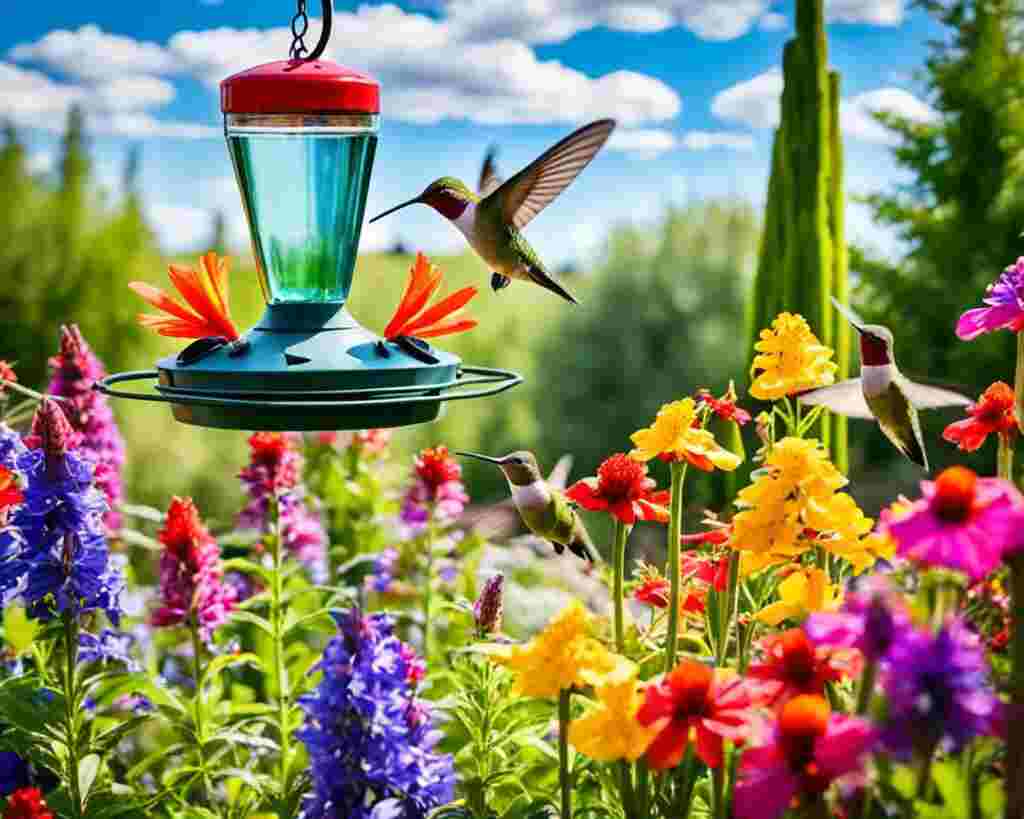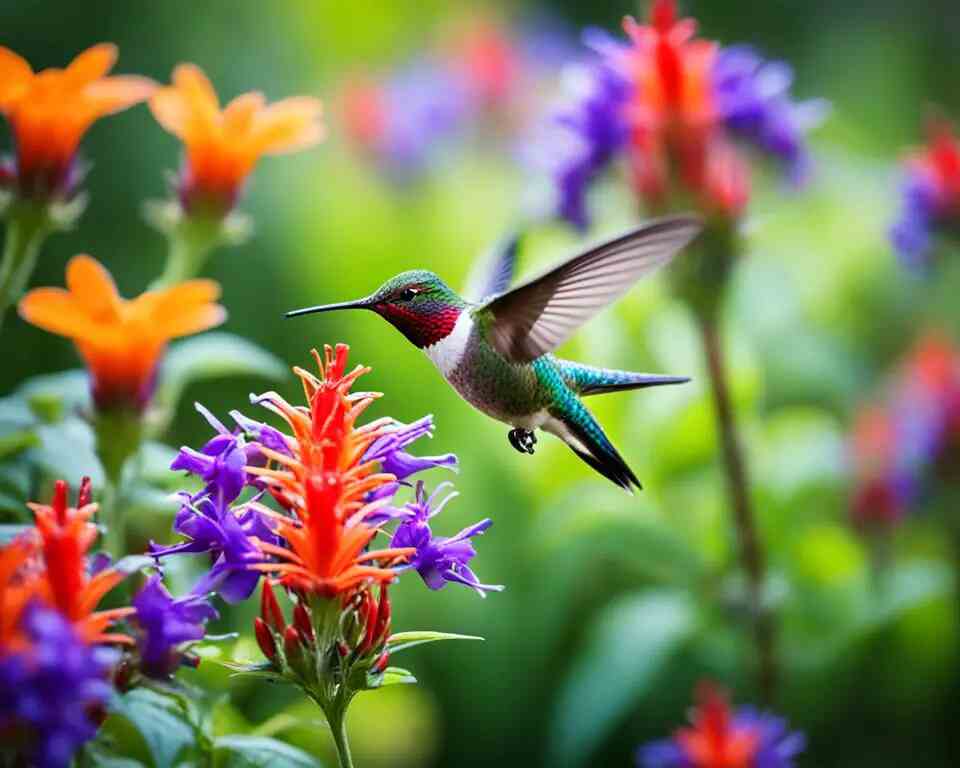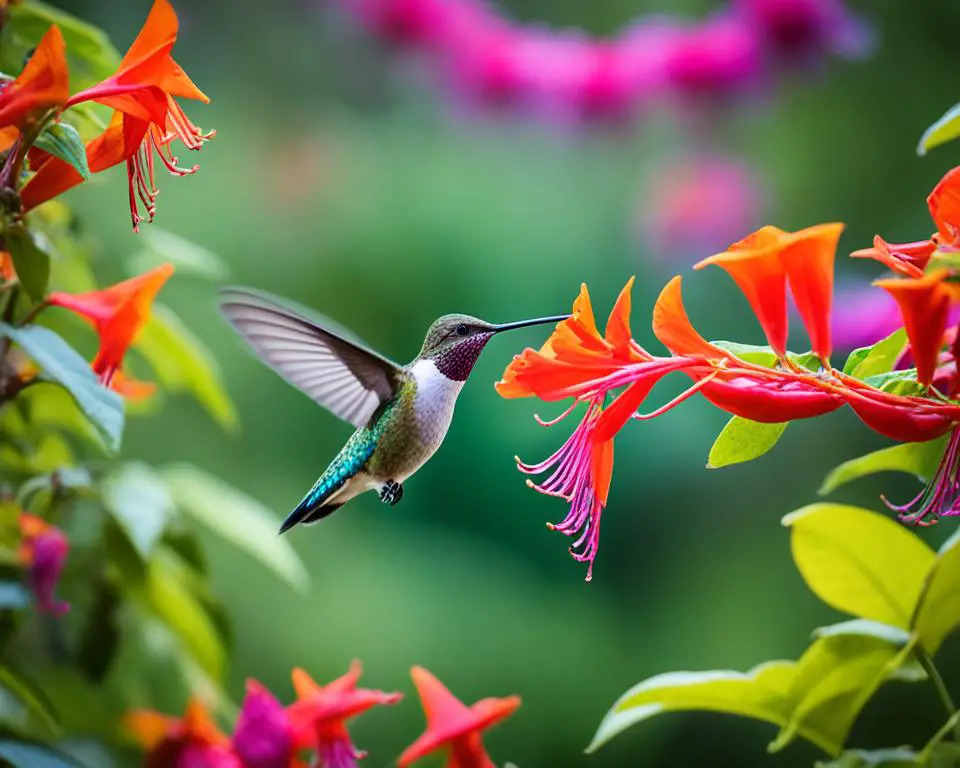Have you ever watched a hummingbird zoom around, shiny and quick? Lots of people love these small birds. Maybe you’ve thought about making your garden a place they love too.
In this article, you’ll learn how to make your garden perfect for hummingbirds. We’ll talk about the best food and plants for them. Also, how to make your garden bloom all season. These tips will help you attract these amazing birds.
Table of Contents
- 1 Understanding Hummingbirds: Fascinating Facts for Gardeners
- 2 How to Attract Hummingbirds to Your Blossoming Space
- 3 The Role of Water Features in Attracting Hummingbirds
- 4 Hummingbird Feeder Placement: Maximizing Visitation
- 5 DIY Hummingbird Feeders for Kids
- 6 Best Practices for Hummingbird Feeder Care and Maintenance
- 7 Supporting Hummingbirds Beyond Your Garden: Conservation Tips
- 8 Conclusion
- 9 Author
Key Takeaways:
- By planting native plants that produce nectar, you can provide the primary food source for hummingbirds.
- Creating a continuous bloom calendar ensures there are always flowers available for the birds to feed on.
- Safe perches and nesting sites are essential for hummingbirds to rest and build their nests.
- Water features can enhance the appeal of your garden to hummingbirds, who are attracted to the sound and movement of water.
- Proper placement of hummingbird feeders near flowers and in visible areas can maximize visitation.
Understanding Hummingbirds: Fascinating Facts for Gardeners
Before diving into the tips for attracting hummingbirds, let’s learn about them. They’re small and have incredible flying skills. They feed mainly on nectar and insects. Also, they travel far distances each year. Getting to know these birds helps us attract them to our gardens.
To attract hummingbirds, know what they like. They’re drawn to certain things. This includes a steady nectar source, colorful flowers, and knowing when they migrate.
Providing nectar is key for these little birds. They have a high metabolism and need lots of nectar for energy. You can make nectar with sugar and water. Don’t add honey or red dye as it’s bad for them.
Colorful flowers also attract hummingbirds. They love bright, tubular flowers like trumpet vine and salvias. Adding these to your garden will attract these birds.
It’s important to know about hummingbird migration. They fly long distances and follow specific paths. Knowing this lets you create a welcoming garden for them during migration.
Use these tips, like offering nectar, planting colorful flowers, and understanding migration, to attract hummingbirds. Your garden will become a favorite spot for these amazing birds.
| Hummingbird Attractant Techniques | How to Make Hummingbird Nectar | Attracting Hummingbirds with Flowers | Hummingbird Migration Patterns |
|---|---|---|---|
| Provide a reliable source of nectar | Mix one part sugar with four parts water | Plant bright and tubular-shaped flowers | Learn about the migration routes |
| Use colorful feeders and flowers | Avoid using honey or food coloring | Choose trumpet vine, bee balm, or salvias | Create a rest stop for migrating birds |
| Hang feeders at different heights | Change the nectar every 3-5 days | Ensure a variety of flower colors | Plant flowers that bloom during migration |
How to Attract Hummingbirds to Your Blossoming Space
To bring hummingbirds to your yard, you need a space that offers the food and shelter they like. Think about these tips when creating your hummingbird garden.
Essential Native Plants for Nectar-Loving Hummers
Planting native nectar plants is a good way to attract hummingbirds. These plants are great food sources for them. Popular choices include:
- Tubular flowers: Trumpet vine, cardinal flower, and bee balm are great for hummingbirds.
- Salvia: Scarlet sage and pineapple sage are big hits with these birds.
- Hummingbird mint: Agastache, or hummingbird mint, is loved by them.
- Penstemon: With many types, penstemon is perfect for attracting hummingbirds.
By adding these plants to your garden, you make a great feeding spot for hummingbirds.
Designing a Continual Bloom Calendar
To keep hummingbirds coming, plant flowers that bloom at different times. This ensures they always have nectar. Add a mix of flowers, shrubs, and trees to give hummingbirds food all year.
Creating Safe Perches and Nesting Sites
Hummingbirds also need places to rest and nests. Offer thin branches or wires for them to perch. Put up feeders near these spots for easy feeding. Dense foliage from shrubs or trees gives them shelter and nest sites.
Adding these features makes your garden a great spot for hummingbirds. By inviting them into your yard, you help them thrive and get to watch their beauty up close.
The Role of Water Features in Attracting Hummingbirds
Water features are key to attracting hummingbirds to your garden. The sound and movement of water draw them. A simple fountain or shallow basin can make your garden more inviting to these birds.
Hummingbirds find natural water for drinking and bathing essential. A water feature can make your garden welcoming. It mimics their natural habitat with running water and light reflections.
When picking a water feature, think about what hummingbirds like. They enjoy shallow basins to bathe and groom. Adding small rocks or pebbles gives them spots to perch and watch their area.
It’s important to keep water clean for the birds. Change it often and clear any debris. This keeps drinking and bathing water safe, helping their health.
Water features are just one way to attract hummingbirds. Including nectar-rich flowers and natural shelters is also key. With these, your garden will be a hummingbird haven, full of life and beauty.
Hummingbird Feeder Placement: Maximizing Visitation
Hummingbird feeders attract these birds to your garden. Properly placing feeders is essential. By placing them strategically, you make your garden a top choice for hummingbirds.
It’s smart to place feeders near flowers. This simulates their natural eating habits. Hummingbirds love bright, nectar-producing flowers. Close feeder placement to these flowers offers easy access to food. It lets them switch between flowers and your feeder.
Feeder visibility matters a lot. Hummingbirds prefer feeders they can easily see. Place them in open spots, like near a window or on a patio. Avoid putting feeders where trees or plants might block them.
Choose feeders made for hummingbirds. Pick ones in bright colors to attract them. Also, consider the feeder’s size and design. Small perches and openings are best for these tiny birds.
Making your own nectar is cheap and easy. Mix four parts water with one part sugar. Boil until sugar dissolves. Cool it before filling the feeder. Don’t add coloring or sweeteners—they’re bad for hummingbirds.
DIY Hummingbird Feeders for Kids
Looking for a fun project to engage your kids and teach them about hummingbirds? Crafting DIY hummingbird feeders can be both educational and entertaining. The eBook “Fun & Easy DIY Hummingbird Feeders for Kids” offers creative and simple designs that children can make with common household items.
By involving kids in creating feeders, you not only foster their creativity but also instill a love and appreciation for nature and these fascinating birds. Check out this resource for some delightful ideas to make your yard a hummingbird haven!
Best Practices for Hummingbird Feeder Care and Maintenance
Taking good care of hummingbird feeders is key for keeping birds healthy. These tips help keep your feeders clean and safe. This way, hummingbirds will keep visiting your garden.
DIY Nectar Recipe: Keeping It Natural and Safe
Making your own hummingbird nectar is cheaper and safer than buying it. Just mix 1 part sugar with 4 parts boiled water. Stir until the sugar dissolves. After it cools, fill your feeders with it. Don’t use artificial sweeteners, honey, or brown sugar—they’re bad for hummingbirds. Change the nectar every 3-5 days, especially when it’s hot, to stop fermentation or mold.
Hummingbird nectar recipe:
- 1 part white granulated sugar
- 4 parts boiled water
Mix the sugar and water in a clean container. Stir until the sugar is all dissolved. Wait for the nectar to cool before you refill the feeders.
Cleaning Routines to Prevent Disease Spread
Cleaning your hummingbird feeders often stops diseases from spreading. Follow these cleaning routines:
- Daily: Look for mold, mildew, or discoloration. Clean the feeder right away if you find any.
- Weekly: Take the feeder apart and clean it with warm soapy water. Scrub the feeding ports and rinse well. Let it air dry before you refill.
- Monthly: Soak the feeder parts in a vinegar and water mix for an hour. This removes mineral deposits. Rinse and dry before putting it back together.
Keeping feeders clean helps them work right. It means the hummingbirds get the food they need.
| Benefits of Proper Hummingbird Feeder Care |
|---|
| 1. Healthier hummingbirds |
| 2. Increased hummingbird activity in your garden |
| 3. Prevention of disease transmission |
| 4. Longevity of your hummingbird feeders |
Supporting Hummingbirds Beyond Your Garden: Conservation Tips
Conserving hummingbirds goes beyond just bringing them to your yard. You can help these beautiful birds by doing a few simple things. Here are some easy ways to make a difference in hummingbird conservation:
Create Natural Habitats
Creating a natural habitat is key to attracting hummingbirds. Plant a mix of native plants that hummingbirds love. Include flowers like trumpet vine, red columbine, and cardinal flower for varied food sources.
Protect Hummingbird Habitat Essentials
Hummingbirds need more than nectar plants. Include trees or shrubs for nesting and clean water for them to drink and bathe. Making sure these essentials are available creates a safe place for hummingbirds.
Attracting Hummingbirds with Water Features
Besides nectar plants, adding water features can attract more hummingbirds. They like the sound and movement of water. A small fountain, birdbath, or sprinkler provides a nice water source for them.
Support Hummingbird Conservation
Help protect hummingbirds by supporting conservation groups. Donate to wildlife groups or join citizen science projects. Your contributions can brighten the future for hummingbirds and their homes.
Conclusion
In this article, we’ve talked about how to attract hummingbirds to your garden. Adding the right plants, food, and environment will make it a perfect spot for them. It’s important to be patient and keep an eye out since it might take a while.
With these simple tips, you’re on the path to enjoying hummingbirds in your garden. Include plants that give them nectar and plan so different plants bloom throughout the year. Also, give them places to perch and nests to feel safe. Adding water features can make your garden even more inviting because hummingbirds like the sound and movement of water.
Make sure to place your hummingbird feeders where they can easily see them, near flowers. Taking good care of the feeders and making a safe, homemade nectar keeps the birds healthy. Lastly, help protect hummingbirds everywhere by working on conserving their natural living spaces.




